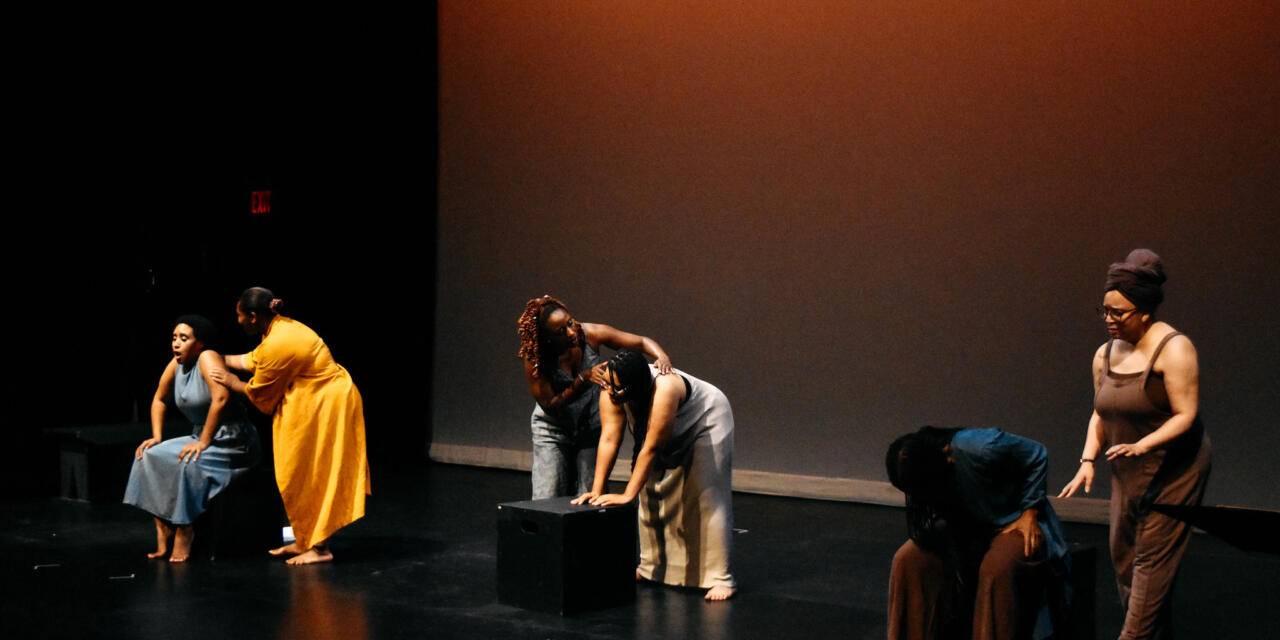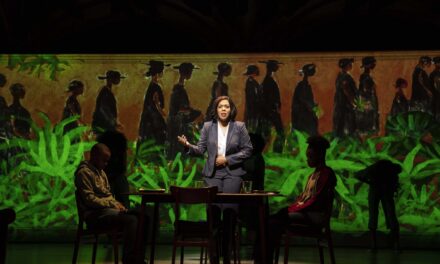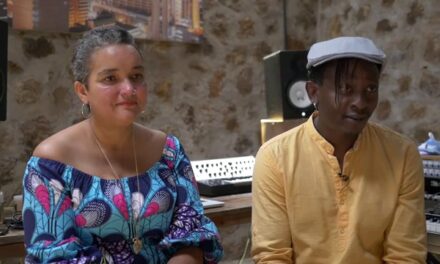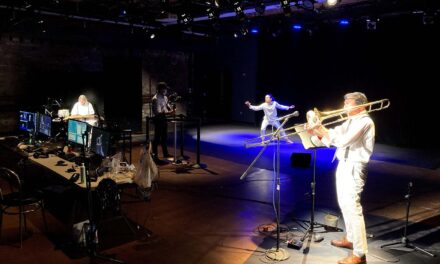Fifteen years ago, The Anthropologists came to be in New York City, a group of devisers born of a deprivation of female-led story and artistic autonomy. One month ago, I was scrolling through their website, following their latest journey, when I received a press release. A few weeks ago, I had the privilege of viewing this work-in-process, axes, herbs and satchels. Motivated by the increasingly-public-knowledge maternal mortality rate of Black birthing people, this newest piece aims to tell the stories of midwives of the past, doulas of the present, a hopeful ecstasy of the future, and the parents and cultures affected throughout. With a team comprised of Black feminine and non-binary bodies, it is shaping up to be a truly powerful work of art.
The journey to axes, herbs and satchels began two years ago. Enveloped in an exploration of bodily autonomy and reproductive rights for their 2021 production, No Pants in Tucson, the team found themselves in a gradual gravitation towards reproductive justice. “It felt like this was such fertile ground for exploration that it couldn’t be contained by one show,” explains Co-Director Melissa Moschitto. From research on traditional medical practices and Black midwifery came a series of investigative labs in the summer of 2022; though only one was specifically addressing doulas and midwives, it was clear what the company’s next deep-dive would be.
These labs are where Sandie Luna, Co-Director, and Jalissa Fulton, Lead Deviser, came to the project. “I’m one of the statistics when it comes to Black maternity health and health inequity,” says Luna, herself a trained doula, “so the explorations last year were, for me, a really exciting opportunity to delve into something that’s embodied experience. As artists, we have these tools that, for better or for worse, make us really curious…and once we have an experience, we want to mirror that back for everyone else who has gone through it, and see how we can make a difference and keep others from going through it.”
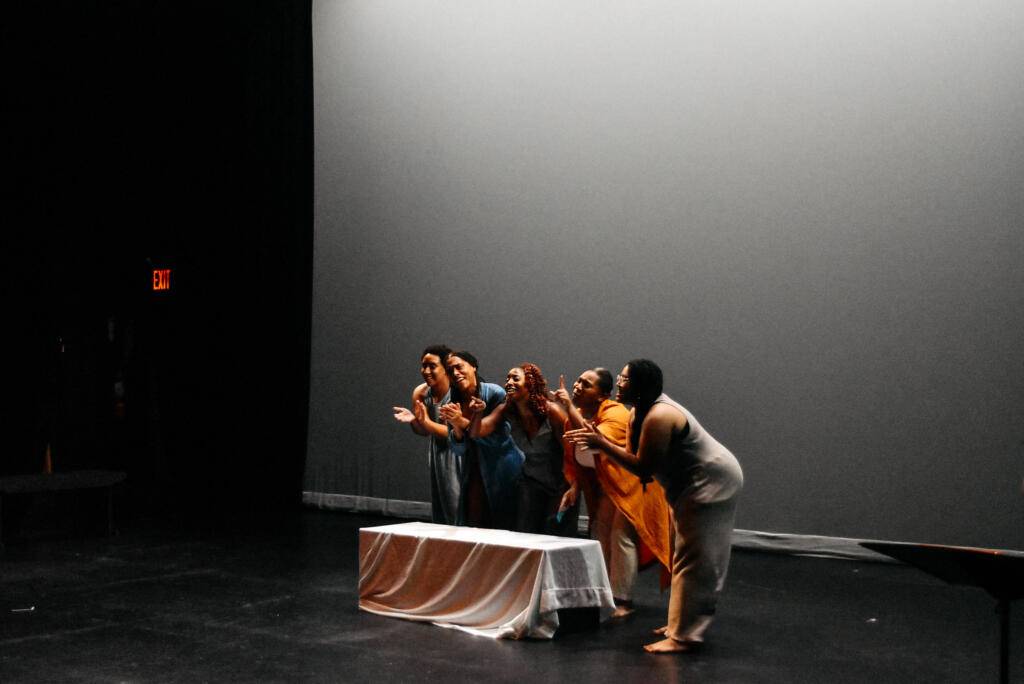
The ensemble of “axes, herbs and satchels.” PC: Isha Patel
“Everything was so rooted and structured in activism,” agrees Fulton. Fortunately, the creative team did not find themselves alone in tackling such a complex topic of activist anthropology: in the spring of 2023, following several discussions with the President of the American Anthropological Association, their own Anthropologist-in-Residence came on board. Dr. Haile Eshe Cole offered decades of experience working with the Black birthing community and years of study in maternal and infant mortality rates among Black women. From Dr. Cole’s first-day resolve that everyone read Killing the Black Body by Dorothy E. Roberts, her research capabilities and access have provided much to these devisers, allowing each “to be able to not just create from what [they] think, but from having a rooted knowledge in the material,” continues Fulton.
“We came at it with an inquisitive approach, willing to question…this was highly influenced by having Dr. Cole as part of our team,” adds Luna. “We were very deliberate about that and very thankful for that.”
Inquisition inherency is apparent in the work The Anthropologists have done thus far. Rarely am I invited to see incomplete productions. Often, I enter the room only when a team is ready to present the most polished version of their piece, with structure solidified and vocals steady. Rarely, as a critic, am I welcomed into a space still “in the draft,” a practicing tenet Moschitto shares with a grin.
There was a beauty to this draft, and the dialogue it prompted, that left me thinking for days afterward. It’s no secret that I hold a love for intersectional feminist stories, a passion for the process, and a fascination with dramaturgy of literary and physical varieties. It was a gift to be invited into this space—the 14th Street Y, lit with a twentieth-century-traditional pink gradient—and hear these voices. Six Black, feminine-carrying bodies graced the stage in a series of vignettes. In one moment, their physicalizations found literality in the presentation of a healer’s bag. In another, their entwinement wavered as a white voice pushed them to and fro, pulling through the endless legal hurdles of obstetrics. In another, three women give birth, two with doulas, one in isolation: the nurse assigned to help each can only speak of “time” and “profit.” Though scripts remained in hand, though times of pause and hesitation reared their heads, there was a resonance deep within these humans’ bodies that was mesmeric. The catharsis and the challenge were clear.
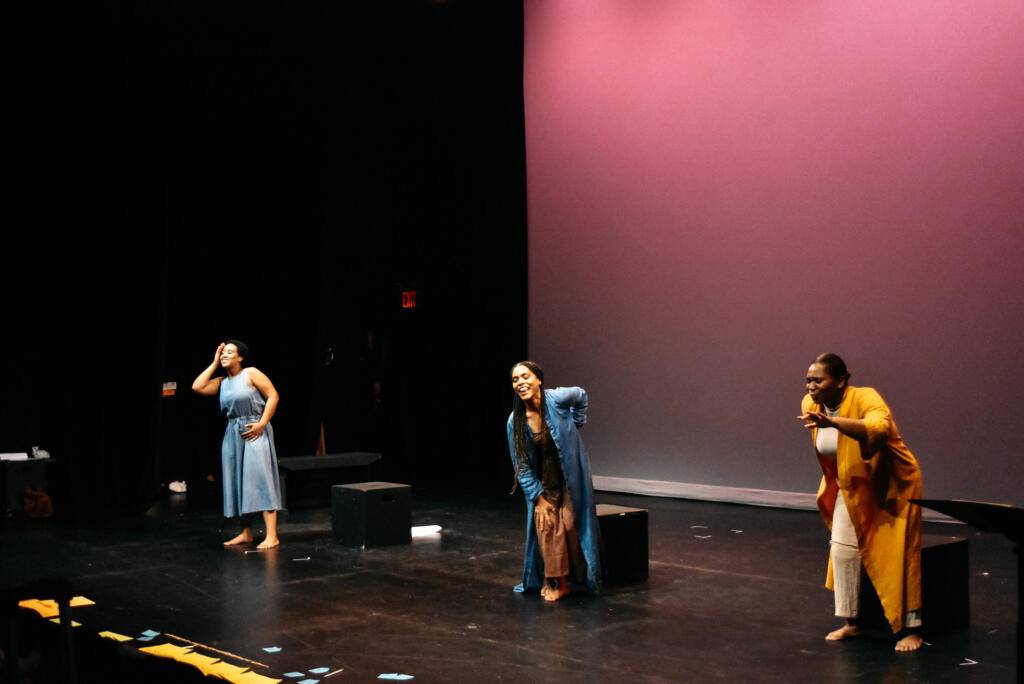
The ensemble of “axes, herbs and satchels.” PC: Isha Patel
Co-Directors Luna and Moschitto have made it their goal to “use research to reframe the narrative, or see what’s been missing from the dominant narrative” (as the latter explains), and that is certainly what is received. Childbirth in an American hospital is not depicted as the filmic joy so many believe it to be: it’s painful, it’s profiteering, it’s parentally ignored. Similar delivery in the 19th and early 20th centuries, what many perceive as arcane, provides far more comfort in the use of fussin’, midwives caring for the mother in a holistic, pampering way. The arrival of white, male obstetricians is not a triumph, but a terrifying moment of banning those well-versed from the birthing room and inviting those with no previous command.
The discovery and construction of narrative is the crux of this work. Querying who we’re hearing from and how their perceptions affect their writing is of extreme importance to The Anthropologists. “I really understand education as not a marker for intelligence [but] a tool,” observes Fulton, “and these people, if they don’t value something, it changes how they write. It changes the way that they talk about the people in the material. It discredits them, in my opinion. We can take what they say, and look at it to gain some kind of perspective, but as far as their work or their work being law, we have to question that.” Many of our preconceived notions when it comes to Black bodies have their origins in 19th-century anthropological writings: those were written by white males, trained at an upper institution, who viewed Black women’s generational wisdom as inferior. axes, herbs and satchels invites its audience to challenge their internalized way of thinking. Where did it come from, and why?
After all, as Moschitto says, “It’s very neatly braided together, the structures of racism and patriarchy that wanted to prevent women…from being authorities about the body and the birthing experience, and also, very specifically, about taking away income and any path towards self-sufficiency.”
This experience is a re-membered one, certainly. The Anthropologists work from the tools and techniques of physical theatre, influenced by Meyerhold and Grotowski; the catharsis emanating from these feminine bodies finds its grounding from the outside-in. “I work from the belief that we already have history and wisdom in our body that is carried generationally,” Luna says. “You’re calling forth things that exist already, somewhere in your body. And even if they don’t, just the fact that you think they do impacts you differently. A lot of [this experience] was just coming back into contact with a way of being. We were accessing knowledge in a way that we’re not used to as a society, which is mining the body for its understanding and what it has experienced.” This belief serves Luna’s ensemble well. There is, inarguably, accession of a well within each person: even if I couldn’t hear the words they spoke at times, I could see it within their carriage, their eyes, and hear it within their breath. There is a depth there that will only provide further affectation to their audience.
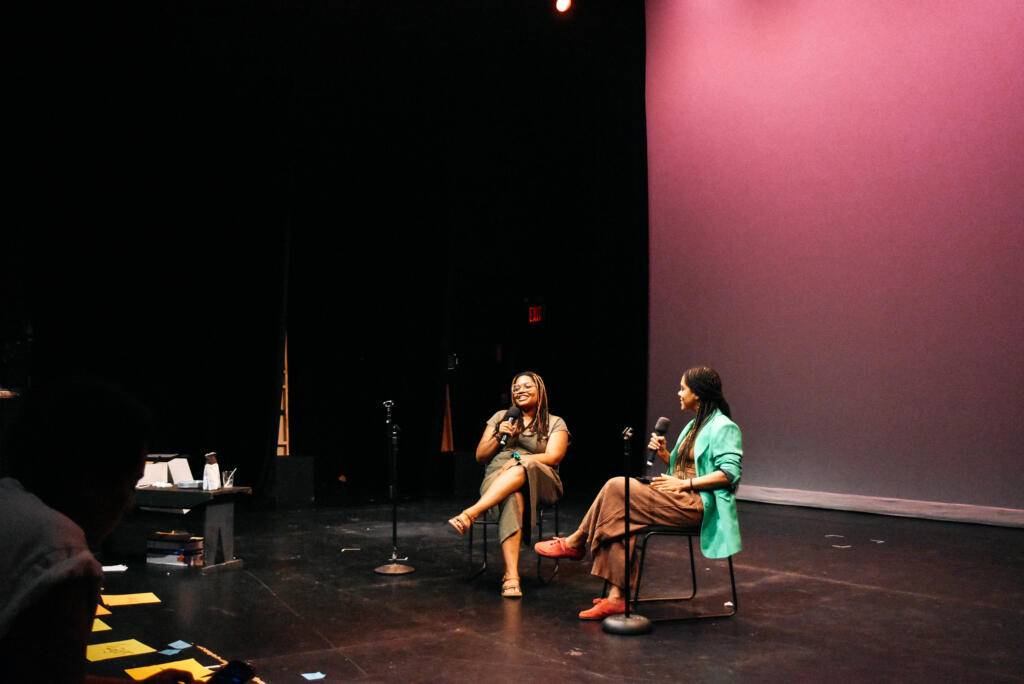
Dr. Haile Eshe Cole (left) and Sandie Luna in a post-show discussion following “axes, herbs and satchels.” PC: Isha Patel
It already is affecting their audience, in fact. The talkback following this work-in-process presentation was full of queries, of sharing, of dialogue between artist and scientist. Folks shared their personal experiences as doula or birther; others talked of hierarchy and derision; still, others asked wonderfully clarifying questions. It is clear that this work, a divine marriage of art and science, is finding its pathway into others’ mindsets.
axes, herbs and satchels has only up to go from here. I cannot wait to be privy to its growth.
To learn more about The Anthropologists and axes, herbs and satchels, click here.
This post was written by the author in their personal capacity.The opinions expressed in this article are the author’s own and do not reflect the view of The Theatre Times, their staff or collaborators.
This post was written by Rhiannon Ling.
The views expressed here belong to the author and do not necessarily reflect our views and opinions.

